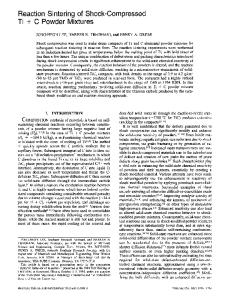Porous Titanium Parts Fabricated by Sintering of TiH 2 and Ti Powder Mixtures
- PDF / 3,360,308 Bytes
- 15 Pages / 593.972 x 792 pts Page_size
- 47 Downloads / 289 Views
JMEPEG (2018) 27:228–242 https://doi.org/10.1007/s11665-017-3099-3
Porous Titanium Parts Fabricated by Sintering of TiH2 and Ti Powder Mixtures Qin Peng, Bin Yang, and Bernd Friedrich (Submitted June 8, 2017; in revised form November 21, 2017; published online December 20, 2017) A new simple powder metallurgy process by sintering TiH2 powders was used to manufacture porous Ti components. The effects of the processing parameters (pressure of cold isostatic pressing and sintering temperature) and the TiH2/Ti ratio in the powder mixtures on the impurities, the linear shrinkage and the pore properties (including overall and open porosities) were comprehensively determined. The addition of TiH2 as a reactant has been found beneficial for the synthesis of porous Ti components. The formation mechanisms of pores were demonstrated based on the dehydrogenation process of TiH2 during sintering, resulting in highest reactivity due to the ‘‘in statu nascendi’’ generation of the metal. In addition, the hardness and corrosion resistance of all the sintered samples were evaluated, related to the overall and open porosities. As a result, an optimal composition of Ti-40 wt.% TiH2 was defined, as its maximum open porosity was about 23%. Keywords
dehydrogenation, porous metal, powder metallurgy, sintering, titanium
1. Introduction Porous titanium can serve the chemical reaction with high degree of dispersion. In addition, the strong resistance potential to corrosion is its outstanding characteristic (Ref 1-3). However, its application has been also severely limited due to the high intrinsic costs. Therefore, cost reduction is one of the major driving forces in the development, manufacturing and processing of porous titanium. In recent years, an alternative PM technique has emerged, which has the potential to reduce the cost of manufacturing titanium and titanium alloys. The new process produces consolidated titanium or titanium alloys by sintering titanium hydride (TiH2) powders, which was first reported by Ivasishin et al. (Ref 4). TiH2 powder has been selected as a material well suited for implementation of these cost-reduction measures in a big program performed jointly by ADMA Products, Inc., RTI International Metals, Inc., Plymouth Engineered Shapes, Inc., and Boeing (Ref 5). Some researchers have found that the use
Electronic supplementary material The online version of this article (https://doi.org/10.1007/s11665-017-3099-3) contains supplementary material, which is available to authorized users. Qin Peng and Bernd Friedrich, IME Process Metallurgy and Metal Recycling, RWTH Aachen University, Intzestr. 3, 52056 Aachen, Germany; and Bin Yang, Institute of Physics, University of Rostock, Albert-Einstein-Str. 23-24, 18051 Rostock, Germany and Competence Centre CALOR, Faculty of Interdisciplinary Research, University of Rostock, Albert-Einstein-Str. 25, 18051 Rostock, Germany. Contact e-mails: [email protected] and [email protected].
228—Volume 27(1) January 2018
of TiH2 powders can improve sintered density, induce mic
Data Loading...











